Many of us try to attract particular types of wildlife to our yards so that we can observe them. We often select plants and other materials that we know provide food, cover, and water for those animals we like to watch. However, when unwanted wildlife visit your yard and cause damage, you might need to consider the use of tactics that could deter these unwanted species.
Developing a strategy for deterring species of wildlife that are causing a specific problem is most efficient if you tailor your tactics to the species causing the problem. To learn more about how to develop an effective and efficient strategy for dealing with nuisance wildlife, see EDIS publication WEC323, Overview of How to Stop Damage Caused by Nuisance Wildlife in Residential Landscapes, https://edis.ifas.ufl.edu/uw368. For tips on how to identify which species is responsible for many commonly reported forms of damage to residential yards, see EDIS publication WEC324, How to Identify the Wildlife Species Responsible for Damage in Your Yard; https://edis.ifas.ufl.edu/uw369.
When are deterrents warranted?
In this publication we provide information on the use of deterrents to stop damage being caused by nuisance wildlife. If you have determined what species is causing the problem and there is no way for you to modify the habitat to encourage the species to leave, deterrents may be your best option.
It is important to recognize that animals tend to become used to all deterrents after a period of time. Animals also tend to ignore deterrents in those situations where they badly need the resources you are trying to protect (i.e., areas where no other forms of food, water, or cover are present). The trick to effective use of deterrents is to (1) begin using deterrents as soon as possible after the problem starts (or even before, if the problem can be anticipated) so animals do not develop a habit of using the resource, (2) switch hazing tactics regularly so animals do not become habituated to a deterrent that is meant to scare them, and (3) use tactics that appeal to more than one sensory modality so animals are bothered in several ways and remain cautious and confused.
This document will discuss three types of deterrents: physical barriers for small, sensitive areas; hazing or scare tactics for temporary alleviation of wildlife problems; and chemical repellents. We provide recommendations on the best deterrent options for each species (see Table 1).
Physical Barriers
Bird Netting
Thin netting can be used to protect individual plants (such as fruit trees and shrubs) by draping the netting over the plants and securing it to the ground with stakes (Figure 1).
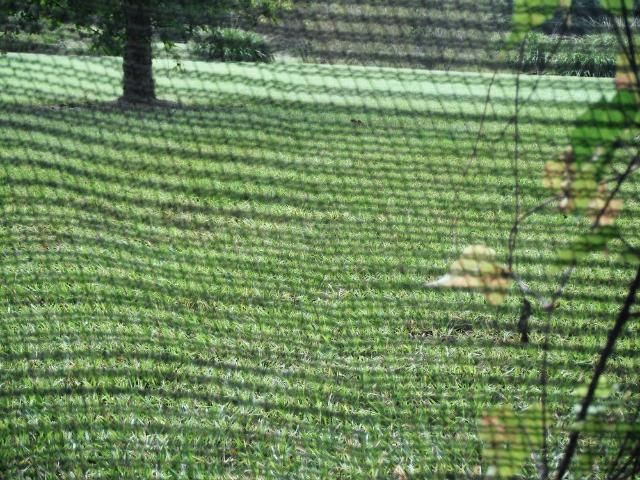
Credit: Holly K. Ober, UF/IFAS
Three-quarter-inch plastic mesh netting is ideal because it is lightweight, pliable, nearly invisible, and often UV-stabilized. This type of mesh will not deteriorate quickly or lose strength when it is exposed to the sun for long periods. Rope netting can also be used for the same purpose. Many forms of netting are sold in black or green, allowing you to select whichever color is least visible.
Note that when setting netting over plants to protect them from birds, you do not want to use extremely thin netting in which birds could get entrapped. All migratory, non-game birds are protected by law.
Temporary Deer Fencing
Plastic mesh can be used to temporarily deter deer (Odocoileus virginianus) from ornamental plantings and fruit trees. Polypropylene mesh is available with UV-inhibitors so that it will not deteriorate quickly when exposed to sunlight. Like bird netting, deer fencing can be draped over vulnerable plantings to prevent deer from feeding. Alternatively, this mesh can be attached to vertical or slanted fences or attached to posts with wire or plastic ties and then placed as a barrier around landscape plantings to prevent deer from gaining access (Figure 2).
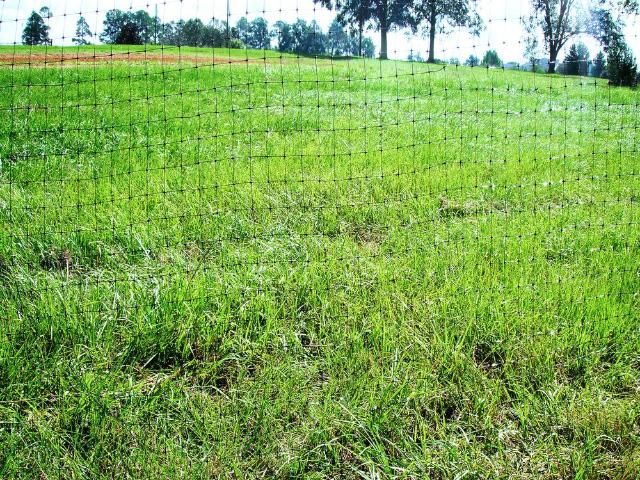
Credit: Holly K. Ober, UF/IFAS
Seedling Tubing
Tough yet flexible UV-inhibited polyethylene and polypropylene mesh tubes can be installed to protect young seedlings from foraging wildlife. Some tubing is made from materials that slowly degrade from sunlight over the course of several years so that once seedlings have grown to a point of establishment the tubing will have disintegrated (Figure 3). For best results, tubes should be installed at the time of planting and should encompass the entire seedling. The tubing works best when cut so that it extends about 1 foot above the seedling: this will enable the tubing to continue to provide protection for future growth. Stakes can be used to provide additional support for the tubing.
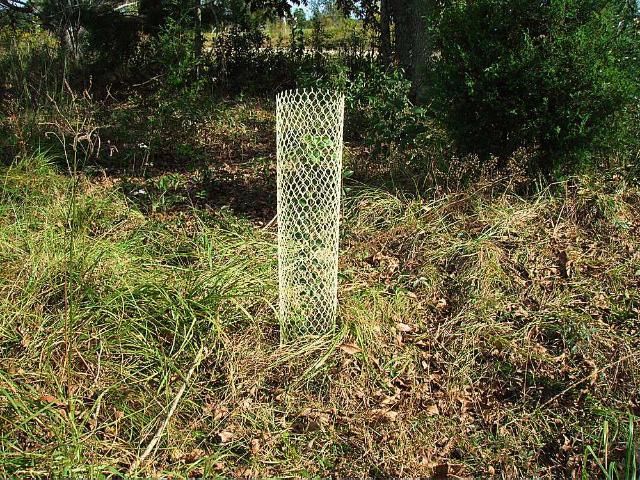
Credit: Holly K. Ober, UF/IFAS
Hardware Cloth or Sheet Metal Barriers
Rigid physical barriers can be created to prevent movement of wildlife to certain areas in your yard or garden (Figure 4). If erected so that the fencing slants outward above the ground and is buried 1.5 feet beneath the ground, these barriers can be effective against burrowing animals such as moles, pocket gophers, and armadillos. These barriers can be especially effective if the mesh is bent outward underground. Use small mesh for moles and pocket gophers (i.e., ¼ or ½ inch); slightly larger mesh sizes will work for armadillos (i.e., 1 inch).
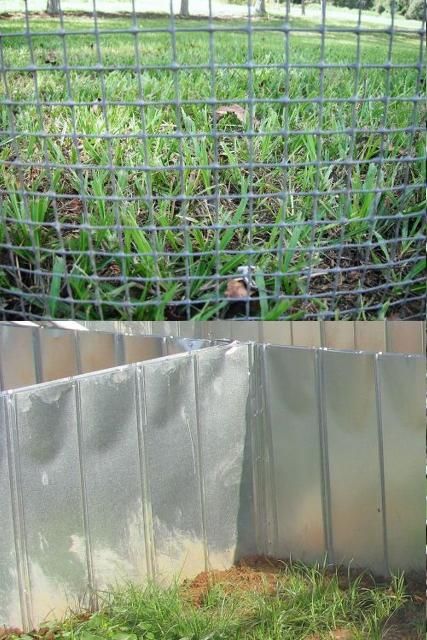
Credit: Holly K. Ober, UF/IFAS
Hardware cloth can also be used to prevent squirrel access to bulbs underground while still allowing shoots to grow through the mesh. Bury the ½ inch mesh completely beneath the ground parallel to the surface of the soil and above the bulbs. For maximum effectiveness, the hardware cloth or chicken wire used to prevent access to bulbs should extend at least one foot in each direction beyond the edge of the flower beds being protected.
Garden Fencing
Inexpensive garden fencing (chicken wire) at least 2 feet tall can be used to limit movement of wildlife such as rabbits, opossums, and skunks in your yard and garden. A simple cylinder of hardware cloth encircling a young tree can prevent rabbit access to succulent new growth.
More durable, thicker-gauge wire mesh can provide long-term relief from larger animals such as deer (Figure 5).
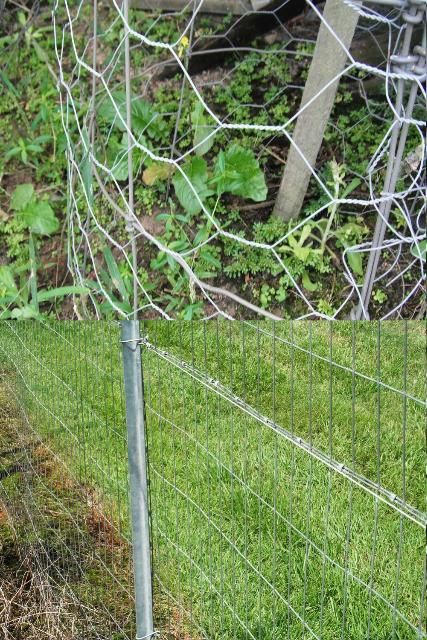
Credit: Holly K. Ober, UF/IFAS
Electric Fencing
A single wire fence 8 inches above the ground can be effective in deterring medium-sized mammals such as raccoons or skunks. Also, a wire mesh fence topped with a single strand of electric wiring can deter small- to medium-sized mammal pests. Taller single-strands baited with peanut-butter-coated foil can provide temporary respite from deer damage. The peanut butter encourages animals to touch their nose to the electric current so they experience the voltage. More permanent fences (high-tensile electric, woven wire, chain link) can provide more lasting protection from persistent deer, but are significantly more expensive and require more regular maintenance. Additional information on excluding deer can be found at https://edis.ifas.ufl.edu/uw128.
Hazing or Scare Tactics
Eyespot Balloons
Weatherproof, inflatable, vinyl balloons with large eyes can be used to repel pest birds (Figure 6). Holographic eyes are especially helpful in creating the illusion that the eyes are following the birds, like a predator ready to attack. The movement of the eyes combined with the natural movement of the balloon in the wind reduces the likelihood that birds will become accustomed to the product.
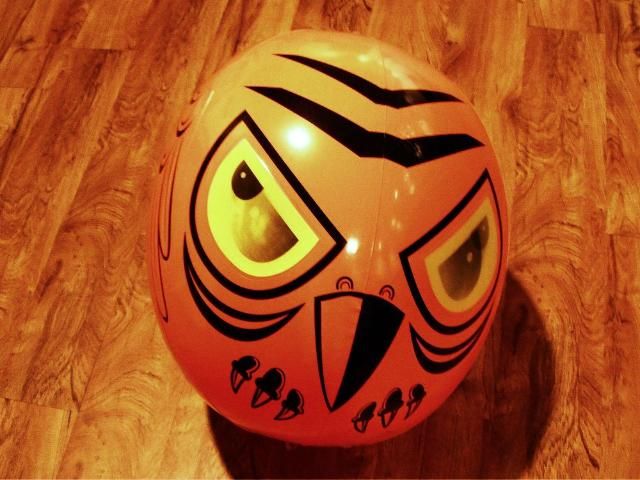
Credit: Holly K. Ober, UF/IFAS
Foil or Mylar Tape
Any type of light-weight ribbon material can be used to scare birds and some mammals (such as deer) for a period of time. However, animals will become accustomed to vinyl ribbon fairly quickly because it only appeals to one sense (i.e., it is a visual deterrent). Foil is preferable to vinyl ribbon because it affects multiple senses (i.e., vision and hearing). Holographic or iridescent foil is even better because it will shimmer in the sun, constantly changing reflections, while also making metallic noises when blown by the wind (Figure 7).
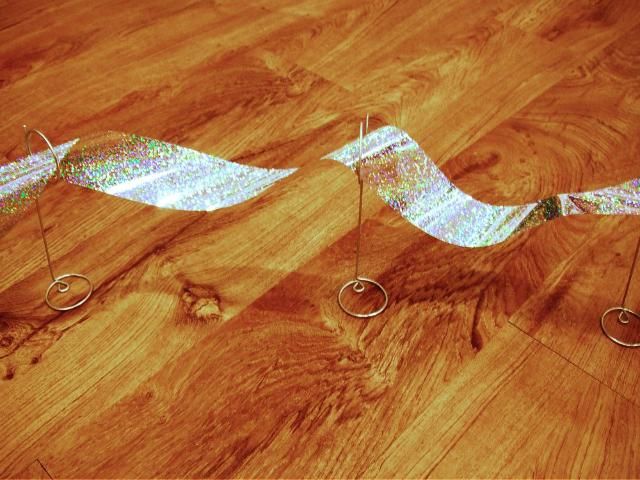
Credit: Holly K. Ober, UF/IFAS
Foil tape can be used several ways. It can be stretched around the perimeter of areas from which deer need to be deterred. Alternatively, short strands can be attached to the top or bottom of other fencing materials to increase the shimmering effect and enhance the noise of the foil fluttering in the wind.
Motion-Sensitive Sprinklers
The surprise of a stream of water aimed directly at an animal can cause it to leave the area you want to protect. Because this tactic could be triggered repeatedly by pets and people during the day, it tends to be more practical for crepuscular and nocturnal offenders, such as skunks, armadillos, and opossums. ("Crepuscular" animals are most active at twilight.) The effectiveness of this tactic may be short-lived, but you may be able to prolong it a bit if you move the sprinkler to new locations regularly.
Noise-Makers and Pyrotechnics
Firecrackers, screamers, horns, bells, whistles, and propane cannons can be used to annoy nuisance wildlife such as raccoons and deer. Alarm call recordings can be used to deter some bird species. However, results are usually temporary because wildlife become accustomed to the sounds once the novelty wears off. Noise-makers are most effective when they are used in combination with other tactics and rotated often.
Dogs
Some wildlife can be deterred by the presence of household pets. Dogs can be especially useful in deterring those wildlife species that are preyed upon by close relatives of dogs (coyotes and wolves). Not only the dog itself but also the smell of its urine and feces may keep some wildlife away.
Chemical Repellents
A wide variety of chemicals are currently available on the market to deter wildlife from foraging on crops and ornamental plantings (see Table 2). These materials vary considerably in cost, effectiveness, and the length of time they remain viable. Most of these deterrents operate through one of several mechanisms: odor aversion, taste aversion, or fear inducement. Odor repellents are materials that smell bad to certain wildlife; taste repellents contain materials that make plants less palatable to some species; and fear-evoking repellents (such as urine from predators) promote instinctual reactions of fear. Most repellents that operate through odor and taste aversion are applied directly to plants and are called "contact repellents." Materials intended to induce fear are called "area repellents" and are either applied to plants directly or are applied to a larger surrounding area to create an invisible odor barrier. Always follow labels carefully when applying a chemical repellent, especially for contact repellents sprayed directly on plant parts, because each repellent is labeled only for use on certain plant species.
Common ingredients in commercially available repellents include capsaicin, naphthalene, predator urine, egg solids, castor oil, garlic, and soap. Products containing capsaicin (an extract from hot peppers) appear to be promising as a topical deterrent for a variety of wildlife species because they operate through both scent and taste aversion. However, animals such as bears like the taste and will lick pepper spray if it is applied to a structure. Additional information on repellents that can be used specifically for nuisance deer can be found at https://edis.ifas.ufl.edu/uw128.
The effectiveness of any particular chemical repellent depends on numerous factors such as the availability of other food items, the stage of growth of the plants to be protected, the abundance of wildlife in the local vicinity, how much time the wildlife has had to become accustomed to consuming the plant before it was treated, and the frequency of reapplication of the repellent. Highest success is likely when a combination of repellents is used, when application is started before damage has begun, and in areas where abundance of the nuisance wildlife species is fairly low.
Control Methods Not Recommended
Repellent tactics that are ineffective in most outdoor situations and are, therefore, not recommended include devices that produce vibrations and ultrasonic noise makers. The use of fumigants and tunnel flooding also does not tend to be effective over the long term for evicting animals that burrow or tunnel. Mothballs and other chemical repellents tend to dissipate outside and are much less effective there than in indoor situations where the odor can be concentrated. Another tactic not recommended because of inefficiency and harm to the environment is the application of insecticides to kill all underground invertebrates that could serve as food for vertebrates such as skunks, armadillos, or moles. These toxic chemicals are also harmful to people, pets, and other wildlife.
Additional Sources of Information
Baker, L. A., D. J. Eakes, G. B. Fain, S. S. Ditchkoff, and C. C. Coker. 2010. An overview and cost analysis of deer repellents for homeowners and landowners. Alabama Cooperative Extension Service Publication ANR-1370. Available online at http://wp.auburn.edu/deerlab/wp-content/uploads/2014/05/64Ext2010-Cost-of-Deer-Repellents.pdf
Main, M. B., J. Schaefer, and G. Allen. 2001. Coping with Deer Damage in Florida. WEC135. Gainesville: University of Florida Institute of Food and Agricultural Sciences. Available at https://edis.ifas.ufl.edu/uw128.
Minnesota Department of Natural Resources—Wildlife Damage Management Program. Nuisance Wildlife Repellent Handbook. Available online at http://files.dnr.state.mn.us/assistance/backyard/livingwith_wildlife/repellent_handbook.pdf
Ober, H. K. and A. Kane. 2012. Overview of How to Stop Damage Caused by Nuisance Wildlife in Your Yard. WEC323. Gainesville: University of Florida Institute of Food and Agricultural Sciences. Available at https://edis.ifas.ufl.edu/uw368
Ober, H. K. and A. Kane. 2012. How to Identify the Wildlife Species Responsible for Damage in Your Yard. WEC324. Gainesville: University of Florida Institute of Food and Agricultural Sciences. Available at https://edis.ifas.ufl.edu/uw369
Ober, H. K. and A. Kane. 2012. How to Modify Habitat to Discourage Nuisance Wildlife in Your Yard. WEC325. Gainesville: University of Florida Institute of Food and Agricultural Sciences. Available at https://edis.ifas.ufl.edu/uw370
Ober, H. K. and A. Kane. 2012. How to Use Traps to Catch Nuisance Wildlife in Your Yard. WEC327. Gainesville: University of Florida Institute of Food and Agricultural Sciences. Available at https://edis.ifas.ufl.edu/uw372
Tregoning, D. and J. Kays. 2004. Using commercial deer repellents to manage deer browsing in the landscape. University of Maryland Cooperative Extension Service Fact Sheet FS-810-A. Available online at https://extension.umd.edu/sites/extension.umd.edu/files/publications/FS810-A_UsingCommDeerReps.pdf